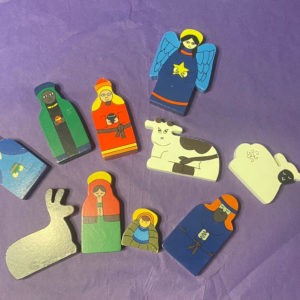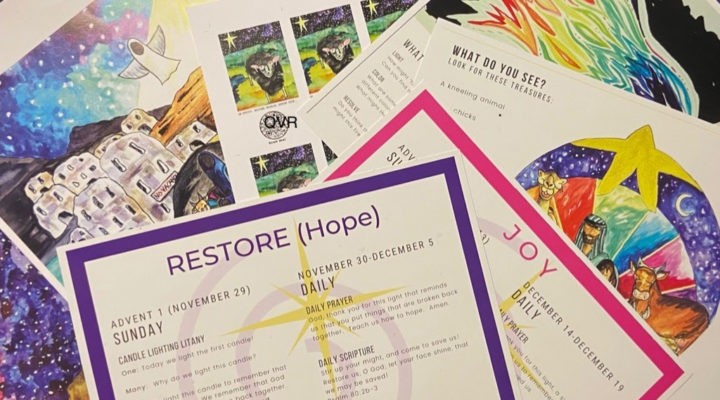A new Advent resource blends the season’s traditional themes of light and hope with social justice causes — all tied up with the goal of promoting faith and community during the pandemic.
The project’s creators, Baptist minister Mary Elizabeth Hanchey and artist Carlye Daugird, definitely have a progressive Christian audience in mind, an audience not typically sought by mass production curriculum providers.

Mary Elizabeth Hanchey
“This is a resource created for those who follow Jesus and who believe that Black Lives Matter and that Jesus was brown, who are queer or queer affirming, who value inclusive and gender neutral language, who expect sound theology, who value creative expressions of faith and faithful expressions of artistry, and who yearn to draw near to the holy,” their online description reads.
Hanchey, an associate pastor at a UCC church in Chapel Hill, N.C., said the world’s political climate shaped the resource for which she provided the text and Dauguird the artwork. But the coronavirus outbreak had an influence, too.
“COVID was one of the reasons we did a big push this year,” she said. “We just knew this was going to be different for churches and for families.”
It’s also an effort not to let faith formation for children and adults fall by the wayside during troubling times. The words and images used in this resource are meant to be meaningful to both groups.
“Progressive Christianity is often very heady and wordy, so it was very important that there be accessible artwork that demonstrated these themes,” she explained. “That makes it more accessible to kids and makes it more accessible to people who are inundated with words and can find meaning in the power of images.”
Hanchey spoke with Baptist News Global about the inspiration and work that went into this unique resource, called “Advent at Home: Restore. Resolve.”
 Have either you or Carlye produced something like this before?
Have either you or Carlye produced something like this before?
We have created a lot of Advent resources for our individual churches. But this is the first time we have done a project for people outside our own personal settings.
What inspired you to collaborate on this project at this time?
Carlye and I have been talking about doing this for several years. But this year I began realizing pretty early on that we were going to miss Advent as church. I know that’s not true for all churches, but we are a big church and do a lot at Advent, a lot of pageantry. And I knew these things would have to be done virtually. I started grieving that pretty early in the summer. I started thinking of ways to create resources accessible not only to children and families, but also to adults who don’t have any children. I wanted people to have tangible access to what the church usually does with Advent.
Have you seen other projects like this one?
We came up with this on our own. It’s been my experience that churches and publishing houses are very good at producing good resources for faith formation or social justice, but rarely both. This was an effort to weave those together for the observance of Advent. Our intent was to give progressive churches resources that are theologically sound but also social-justice oriented.
“Our intent was to give progressive churches resources that are theologically sound but also social-justice oriented.”
How important is Advent in faith formation?
Advent is really important because it’s the space that holds Christmas at bay. Santa Claus is already at Lowe’s. I was just there. There are already blow-up Santas there. But at church, Christmas doesn’t come until the end of Advent. It helps us lean into the waiting that precedes the Christmas story. And it is important to carry that season of waiting into our homes and for families and individuals to observe Advent in a way that keeps them connected to what the church is doing.
The description of your resource says it’s intended for an audience of Jesus followers who believe in Black Lives Matter, who believe Jesus was brown, who are queer affirming, who value gender-neutral language and who want sound theology. How do you and Carlye tie all that together?
First, I need to explain how the project is structured. The themes originated in the lectionary to tie us in with what the churches are doing. But as I worked with the lectionary text for this year, I felt some other themes emerging and I wanted to use some ideas that were more powerful and edgy because of the season we are in with the politics of the world.
The themes that emerged were: “Restore,” referring to hope, for the first week; the second week is “Comfort”; the third week we left as “Joy,” because that is traditional; and the fourth week we named “Resolve” because we wanted to talk about the gritty, hard work of loving. These themes are tied into the realties we’re facing right now as a people of faith.
To get back to the original question, Carlye took the Black Lives Matter and queer-affirming themes and represented them in the artwork. She included rainbows in three of the pieces that are inclusive and affirming. I did the writing, and the writing never uses gendered language for God or for people. There isn’t language about LGBTQ or Black Lives Matter in the text, but we put those symbols into the art because that’s much more powerful. The text focuses on Scripture and prayer.

Carlye Daugird
How is the Black Lives Matter theme portrayed?
Both times Carlye painted the baby Jesus, his hand can be seen reaching out with a fist that is often associated with the Black Lives Matter movement. The language is about Scripture and our faith, and the social justice issues are represented in the artwork and in the prayers we use. One prayer says thank you for putting things back together that are broken. Another helps us to dream of peace. We use language that we hope points people to connecting their faith with justice.
Your project also is described as accessible to those who are alone at the holidays. Is this a reference to social isolation in the pandemic?
The pandemic has caused us to be more aware of how many people are alone and lonely, but it’s not the only reason people are alone and lonely.
Advent resources often portray the season as a happy time when families get together, and for a lot of people that is not always the case. With faith formation, it’s important that resources not be tailored only to big, happy families. The resource we’ve created can be used by people gathered together or you can get on the phone or Zoom to light your candle with others.
“Advent resources often portray the season as a happy time when families get together, and for a lot of people that is not always the case.”
What practices do you promote for Advent?
There is a liturgy for lighting the Advent candle. There is a Scripture passage that is curated from the Scripture reading in the lectionary. There also are daily prayers that we encourage people to say when they light the candle each night. Because listening to good music is a spiritual practice, we have created a curated Spotify playlist. The playlist is thematic and goes in order through the themes of Restore, Comfort, Joy and Resolve. The music is mostly by artists who are queer or queer affirming. We really made the effort to highlight those artists because they are really hard to come by and we feel amplifying their work is really important.
What else would you like us to know?
So often, Sunday school literature, and Christmas and Advent literature has unnecessary portrayals of families that are hetero-normative and who seem happy and traditional in their gender roles.
The way we countered that was by saying this isn’t about family and this isn’t about people. We didn’t draw pictures of parents and children and with presents. This is about the story of Jesus, and it’s at the story about our faith. That story doesn’t need hetero-normative portrayals of family or any portrayals of family.
I have done a lot of work in fertility grief, and Christmas is a time when churches mess that up by portraying it as a time of waiting for a baby. That can cause real harm to those who are struggling with infertility or who have had miscarriages. But Advent is not about waiting for a baby. We are waiting for the inbreaking of Jesus into our world.


